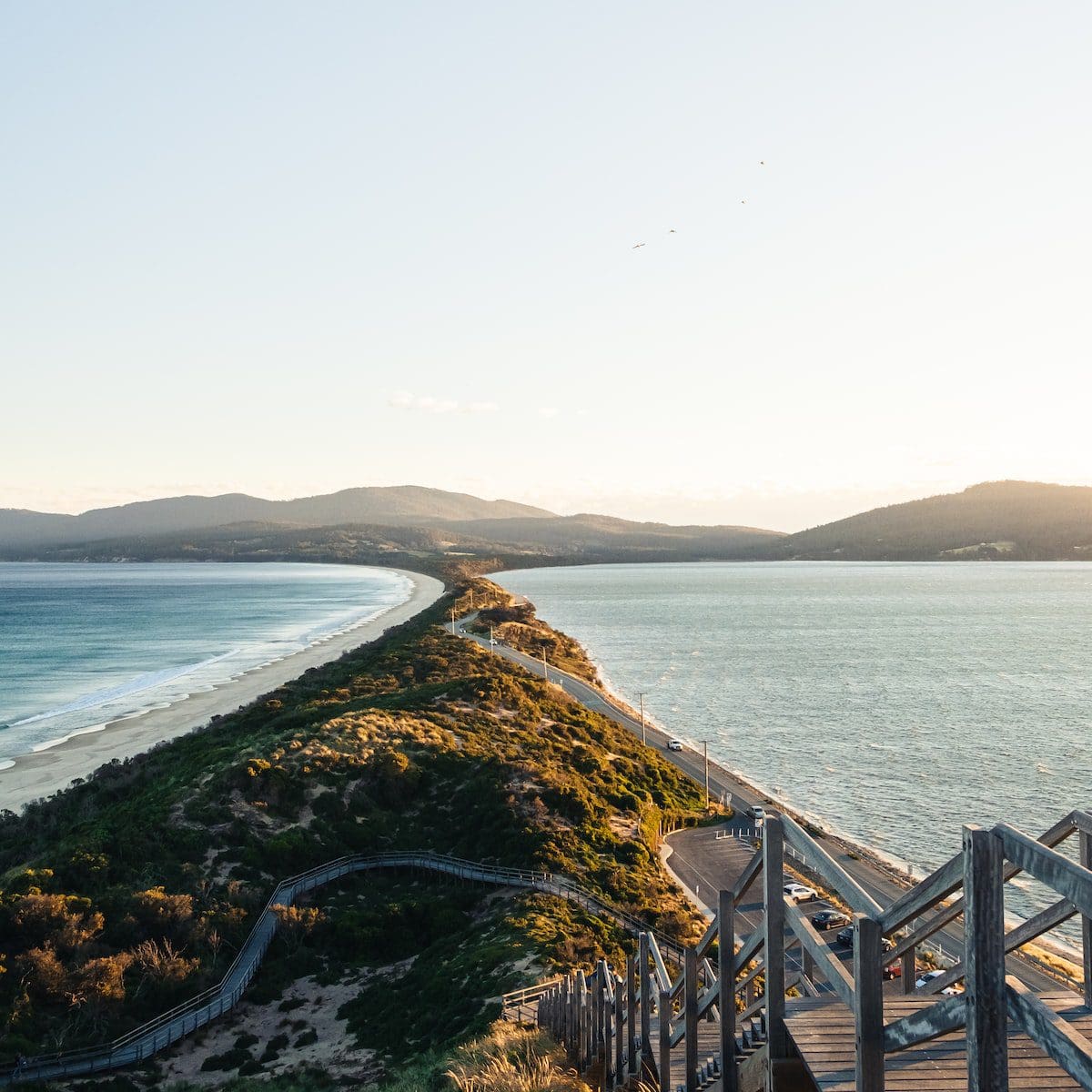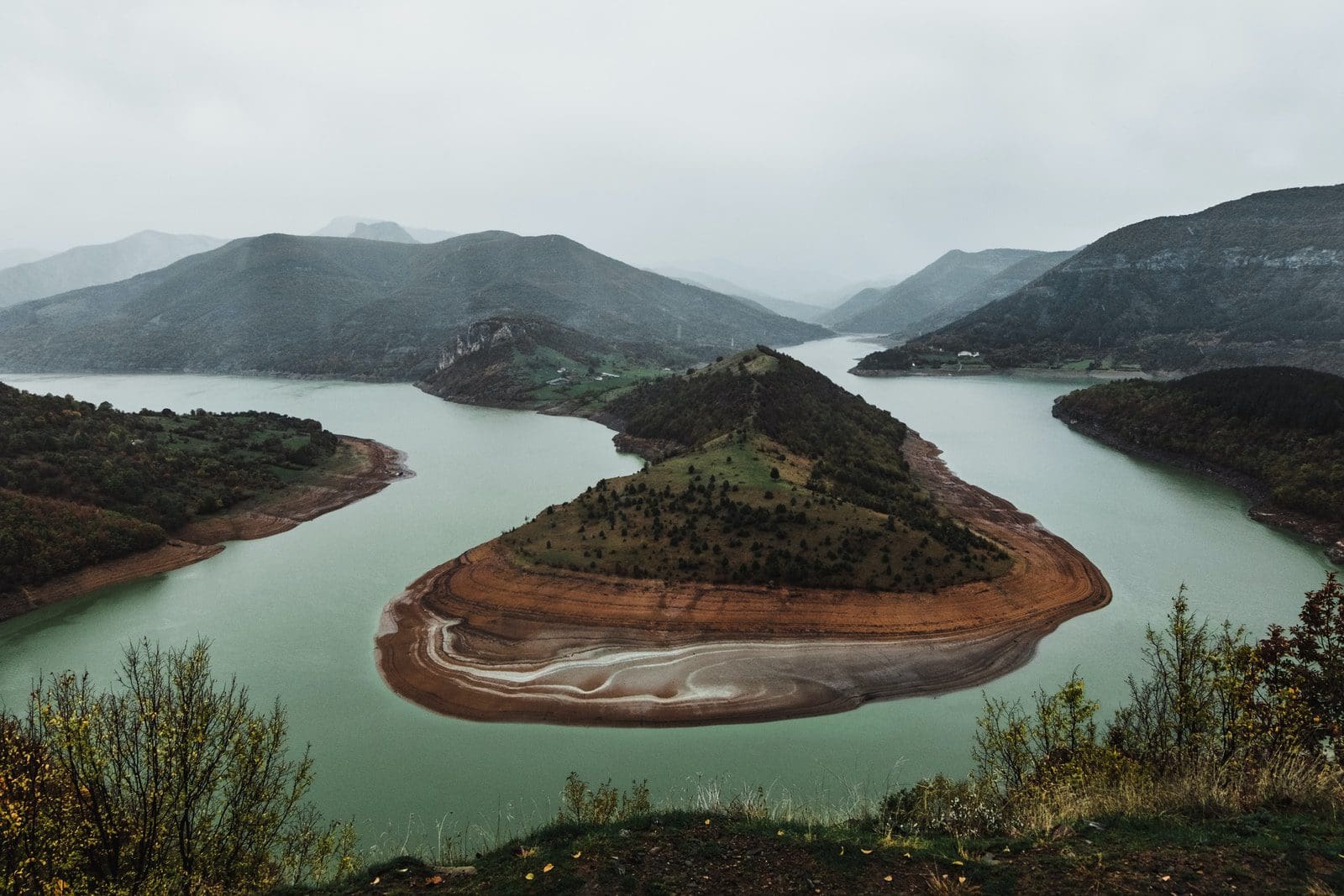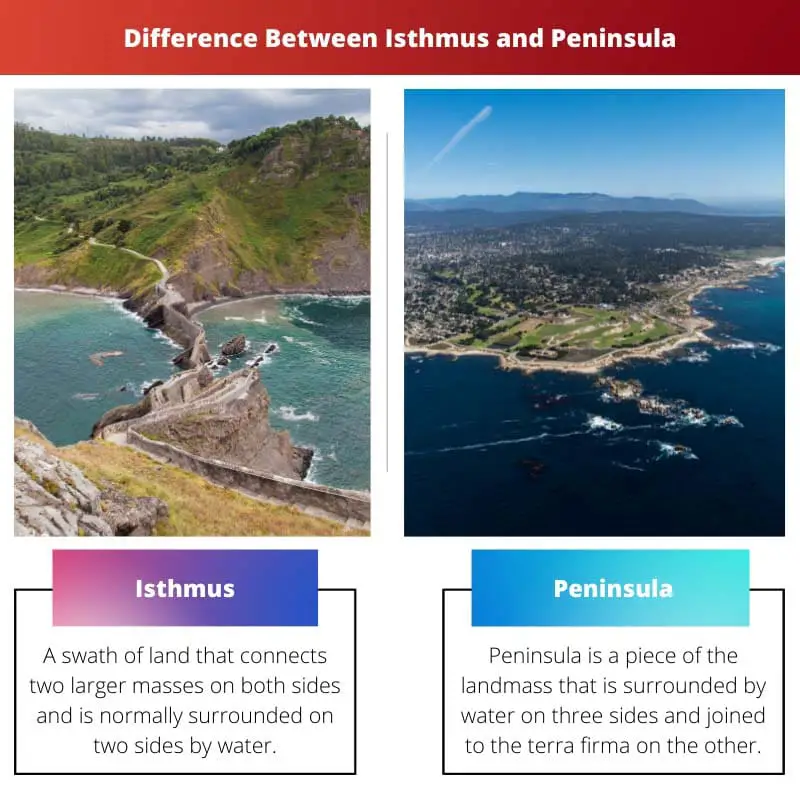An Isthmus and Peninsula are major geographic features that serve many purposes. Many peninsulas of the world are important national parks and major tourist attractions. Isthmuses are locations that connect two land masses and are sites for the construction of ports and canals.
They also help in the exchange of flora and fauna from one landmass to the other. Thus they help in the growth of the economy.
Key Takeaways
- An isthmus is a narrow strip of land connecting two larger landmasses, while a peninsula is a landmass surrounded by water on three sides.
- Isthmuses are crucial for transportation and trade, whereas peninsulas serve as natural harbors and strategic locations.
- Examples include the Isthmus of Panama and the Florida Peninsula.
Isthmus vs Peninsula
Isthmus is a narrow strip of land that connects two larger land masses, while a peninsula is a piece of land that is surrounded by water on three sides. For example, the Isthmus of Panama, North and South America, while the Italian Peninsula is a larger piece of land in the Mediterranean Sea.

Isthmuses have been points of strategic importance, trade and are also used for military purposes. They serve as links between two landmasses and help in the migration of species from one landmass to the other.
They serve as key locations for the construction of ports, canals and sea trade routes.
A Peninsula is formed due to the gradual rise of water that surrounds low-lying land. Examples of some famous peninsulas are the Horn of Africa or the Somali Peninsula, Somalia Paria Peninsula, Venezuela, Indian Peninsula.
A number of pensioners are used as resorts, National parks and areas of conservation—for example, the Point Pelee national park in Ontario.
Comparison Table
| Parameters of Comparison | Isthmus | Peninsula |
|---|---|---|
| Definition | A swath of land that connects two larger masses on both sides and is normally surrounded on two sides by water. | Peninsula is a piece of the landmass that is surrounded by water on three sides and joined to the terra firma on the other. |
| Plural | Isthmuses | Peninsulas |
| Habitation | Usually Uninhabited | Usually Inhabited |
| Access | Land, water and air | Land, water and air |
| Connection to land | Connected to land on two sides | Connected to land only on one side |
What is Isthmus?
A swath of land that connects two larger masses on both sides and is normally surrounded on two sides by water. For decades, isthmuses have served as strategic locations. They are natural locations for ports and canals that connect terrestrial and aquatic trade routes.
The Isthmus of Panama acts as a natural bridge between North and South America and splits the Pacific and the Atlantic oceans. The Panama Canal built on it has transformed the face of shipping and travel forever. It allows faster and more effective travel and transportation of people and goods.
Isthmuses have been important sites for the construction of ports and canals and act as links between land and sea trade routes. For example, the Isthmus of Suez acts as a bridge between Africa and Asia and divides the Mediterranean and the Red Sea.
The Suez Canal, which was built on the Isthmus of Suez in the 19th century, continues to be an essential route for the oil trade.
Isthmuses are formed through various geological activities. Some experts believe that Thomas of Panama was formed by volcanic activity that resulted in a chain of islands. Over time, the sediments from the islands collected in between them and formed the Isthmus.

What is Peninsula?
Peninsula is a piece of the triangular landmass that is surrounded by water on three sides and joined to the terra firma on the other. If a peninsula is located in an inland body of water, for example, a lake or river, it is called an inland Peninsula.
Peninsulas vary in size. They can be quite small, sometimes only large enough for a lighthouse. Lighthouses are built on Peninsulas that are situated on rocky coasts to warn sailors that they are approaching land.
Examples of a large Peninsula are the Indian Peninsula. The majority of Florida is a peninsula that separates the Gulf of Mexico from the Atlantic Ocean.
A peninsula is formed due to the gradual rise of water that surrounds the land lying at a low level. The word Peninsula came/originated from the Latin word peninsula, which stands for “almost an island”.

Main Differences Between Isthmus and Peninsula
- A swath of land that connects two larger masses on both sides and is normally surrounded on two sides by water. On the other hand, a peninsula is a piece of landmass surrounded by water on three sides and joined to the terra firma on the other.
- An Isthmus is connected to the land on two sides, while a Peninsula is connected to the mainland only on one side.
- 3. An Isthmus is narrower than a peninsula.
- An Isthmus is uninhabited, while a Peninsula is inhabited by people.
- An Isthmus is formed due to a series of events like tectonic plate movement or volcanic adoptions, due to which the seabed rises, and the sediments are joined together to form the Isthmus, while a peninsula is formed through the gradual rise in water level surrounding land at a lower


I appreciate the in-depth explanation of the geological formation of isthmuses and peninsulas, which adds further depth to the understanding of these landforms.
Agreed, the geological details are thought-provoking and enhance the grasp of the subject.
The article provides a fascinating insight into the development of these geographical features, which enriches the overall learning experience.
I appreciate the comparisons and the explanation of the different landmasses and how they affect the economy and trade.
I agree, the examples provided are very illustrative and help in understanding the concepts better.
The comments are well-informed and educational.
The article is a valuable resource for anyone seeking to learn more about the distinct characteristics and roles of isthmuses and peninsulas in geography and global activities.
Well-said. The article serves as an educational reference that offers clarity on the topic.
I found the detailed comparison table very helpful as it neatly summarizes the distinctions between isthmus and peninsula and how they are connected to habitation and access.
Absolutely, the presentation of the comparison table is quite informative and easy to understand.
The descriptions of what isthmuses and peninsulas are and their significance are very enlightening.
The article effectively outlines the significance of isthmuses and peninsulas in global trade and transportation, thus highlighting their vital economic roles.
Absolutely, the article’s emphasis on the economic impact of these geographic features is particularly enlightening.
I agree, the economic aspects discussed are of great relevance and contribute to a more comprehensive understanding of the topic.
The article provides a comprehensive summary of the characteristics of isthmus and peninsula, as well as their importance. It’s a valuable source of information.
I couldn’t agree more. The article thoroughly explains the key differences and the significance of these geographic features.
The historical significance of isthmuses and peninsulas in relation to trade and maritime activities is well-presented in the article, offering a deep historical context.
The historical perspective adds an extra dimension to understanding the evolution and influence of these geographic features.
The historical and geographical contexts provided make the article a compelling read, as it delves into the multifaceted roles of isthmuses and peninsulas.
I couldn’t agree more. The comprehensive approach to exploring these geographical features is truly commendable.
Absolutely, the article’s interweaving of historical and geographical details adds depth and richness to the content.
The examples provided for various peninsulas around the world help in visualizing and understanding how diverse these geographical formations can be.
I found the examples to be an excellent addition to the article, making it more relatable and engaging.
The article effectively presents the main differences between isthmuses and peninsulas, making it accessible for readers to comprehend the unique features of each geographic formation.
The clarity of the article’s explanations is commendable and makes it an excellent learning material.